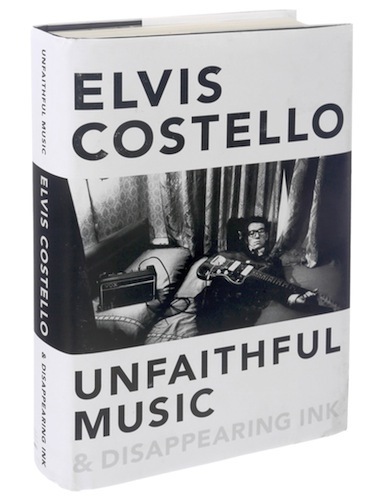
10.22.2015
ELVIS COSTELLO’S AUTOBIOGRAPHY OFFERS MUSICAL INFLUENCES, CELEBRITY ANECDOTES AND ROCK AND ROLL MYTHOLOGY
Houston Chronicle: Bob Ruggiero: October 18th 2015
“Writing about music,” Elvis Costello once said, “is like dancing about architecture.”
This quote has been used against music journalism and journalists for decades. But here’s the thing: Elvis Costello didn’t actually say it.
He was quoting comedian Martin Mull but repeated it enough during interviews that he started getting the credit.
In Costello’s deep and expansive autobiography, the man born in London as Declan MacManus sorts through the truths, falsities, exaggerations, contradictions, triumphs and tragedies found in that other guy, “Elvis Costello.”
The huge, black-framed Buddy Holly glasses? His record company thought it would make him stand out visually: “It was like Superman in reverse,” he writes.
The name? His managers thought that calling him “Elvis” was a surefire publicity generator, though he did ask traveling companions in the American South to call him “Kent” so as not to provoke anger. “Costello” was one of the pseudonyms his musician father used when performing.
When he first came on the scene in 1977 with “My Aim Is True,” Costello was lumped into the punk or new wave genres because he was English, looked weird and recorded for Stiff Records.
But as his career unfolded, the restless gypsy would make music ranging from rock, pop, country and soul to standards, jazz and classical. It’s almost as if the albums “This Year’s Model,” “Almost Blue,” “Blood & Chocolate,” “The Delivery Man” and “Momofuku” could not have come from the same artist.
Some of the most vivid writing in “Elvis Costello: Unfaithful Music & Disappearing Ink,” recalls Costello’s early tours of America. His adventures included many moments of wonder, such as discovering a record store open at midnight, or finding an attractive Italian girl who would take you home between club sets and introduce you to her father and brothers.
“For everything I thought I knew about America, you could say the opposite was the truth,” Costello writes. “It was the most wanton place and the most prohibitive, both seductive and prim. For every brash sales pitch and disposable thrill, there was decency and strange, deep traditions that European clichés about America often overlooked.”
As expected, Costello is passionate about sharing his own musical likes and influences. By book’s end, any budding record nerd has a serious syllabus of homework listening.
Likewise, he includes many anecdotes from artists ranging from Bruce Springsteen, David Bowie, Bob Dylan and Van Morrison to Tony Bennett, Chet Baker and Paul McCartney – the last of which Costello has written a batch of songs with. And who knew he loved boogie rockers Little Feat?
His all-time favorite singer – with whom he also got to record – was George Jones. And when he toasted Jones as the “greatest country singer in the history of the world,” in front of no less than the imposing figure of Johnny Cash, even the Man in Black agreed with him.
Costello details the real-life inspirations behind some of his better known songs including “Alison” (a beautiful, but sad-faced grocery clerk), “Oliver’s Army” (English troops in Belfast), “Veronica” (his mother’s fading memory), “Watching the Detectives” (his love of American film noir) and “Accidents Will Happen” (a tryst with a very attractive Mexican female taxi driver).
Ironically, perhaps his most famous tune – “(What’s So Funny ‘Bout) Peace, Love and Understanding” – was written and originally performed by his buddy, Nick Lowe.
Costello offers his versions of two career events that have transcended their origins and slipped into rock ‘n’ roll mythology.
The first involves an infamous December 1977 appearance on “Saturday Night Live.” As he and the Attractions (Steve Nieve, Bruce Thomas and Pete Thomas) started their final number, Costello stopped the band cold and they immediately launched into a ferocious version of “Radio, Radio.” They had been told they couldn’t play the song, likely due to its anti-corporate music message.
Producer Lorne Michaels quickly “banned” the group from performing on SNL ever again. But he must have had a change of heart because for the show’s 25th anniversary special, just as the Beastie Boys were about to launch into “Sabotage,” Costello appears, interrupts them, and they tear through “Radio, Radio.”
The other incident, less savory, took place in 1979 at a Holiday Inn bar in Columbus, Ohio. A blind drunk and provocative Costello – in the company of rockers Stephen Stills and Bonnie Bramlett – made a few ugly and disparaging racial comments about James Brown and Ray Charles, ironically, two of his musical heroes.
A fistfight ensued, and Bramlett told the press. The incident branded Costello a racist, despite a mea culpa press conference, years of penance and his own seemingly sincere personal shame.
Perhaps it’s not surprising that one of rock’s most literate songwriters would pen such a deep, free-form memoir. Costello’s journey from dingy Liverpool pubs to the East Room of the White House is certainly worth following, even if the chronology jumps all over the place, he barely mentions his second wife (former Pogues bassist Cait O’Riordan) and a more than passing knowledge of his music is required to get the most out of the book.
The Grammy Award-winner and Rock and Roll Hall of Fame member may even have some juice left for another tome. While he continues to tour, record and raise twin boys with his third wife, jazz singer/pianist Diana Krall, Costello has found time to work on about 40 new songs.
Seems like he may have gained the love and understanding, but days of quiet peace are surely rare.VIEW MORE NEWS